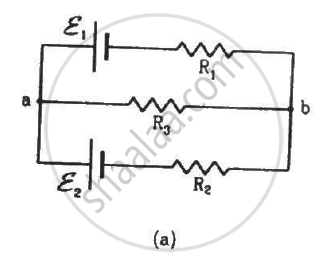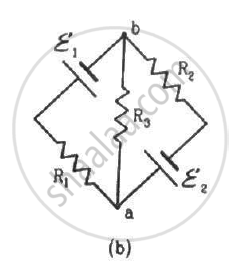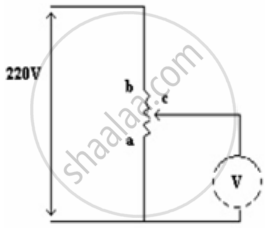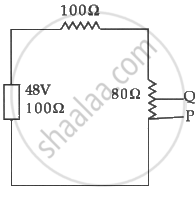Advertisements
Advertisements
प्रश्न
The following figure shows a part of a circuit. If a current of 12 mA exists in the 5 kΩ resistor, find the currents in the other three resistors. What is the potential difference between the points A and B?

उत्तर

Let the current flowing through the resistors be marked as shown in the figure.
Given: i = 12 mA
The resistors of 20 kΩ and 10 kΩ are connected in parallel. So, the potential difference across their ends will be same, i.e.
\[20 i_1 = 10\left( i - i_1 \right)\]
\[ \Rightarrow 30 i_1 = 10i\]
\[ \Rightarrow i_1 = \frac{i}{3} = \frac{12}{3} = 4 mA\]
∴ The current flowing through the 20 kΩ resistor = i1 = 4 mA
The current flowing through the 10 kΩ resistor = i - i1 = 8 mA
From the figure,
The current flowing through the 100 kΩ resistor = i = 12 mA
The equivalent resistance between the points A and B,
\[R_{net} = \left( 5 + \frac{20 \times 10}{20 + 10} + 100 \right) k\Omega = 111 . 67 k\Omega\]
The potential difference V between the points A and B,
\[V = i R_{net} \]
\[ \Rightarrow V = 12 \times {10}^{- 3} \times 111 . 67 \times {10}^3 = 1340 V\]
APPEARS IN
संबंधित प्रश्न
When 5 V potential difference is applied across a wire of length 0.1 m, the drift speed of electrons is 2.5 x 10-4 m/s. If the electron density in the wire is 8 x 1028 m-3, calculate the resistivity of the material of the wire.
In a series LCR circuit, what is the phase difference between VL and VC where VL is the potential difference across the inductor and V c is the potential difference across the capacitor?
Describe the working principle of a solar cell. Mention three basic processes involved in the generation of emf.
Why are Si and GaAs preferred materials for solar cells?
Why is potentiometer preferred over a voltmeter for comparison of emf. of cells?
The emf of a cell is always greater than its terminal voltage. Why? Give reason.
The potential difference between the terminals of a battery of emf 6.0 V and internal resistance 1 Ω drops to 5.8 V when connected across an external resistor. Find the resistance of the external resistor.
Find the potential difference Va – Vb in the circuits shown in the figure.


A voltmeter consists of a 25 Ω coil connected in series with a 575 Ω resistor. The coil takes 10 mA for full-scale deflection. What maximum potential difference can be measured by this voltmeter?
A 6-volt battery of negligible internal resistance is connected across a uniform wire AB of length 100 cm. The positive terminal of another battery of emf 4 V and internal resistance 1 Ω is joined to the point A, as shown in the figure. Take the potential at B to be zero. (a) What are the potentials at the points A and C? (b) At which point D of the wire AB, the potential is equal to the potential at C? (c) If the points C and D are connected by a wire, what will be the current through it? (d) If the 4 V battery is replaced by a 7.5 V battery, what would be the answers of parts (a) and (b)?

If a constant potential difference is applied across a bulb, the current slightly decreases as time passes and then becomes constant. Explain.
A potential difference of 220 V is maintained across 12000 Ω rheostat. Then voltmeter V has a resistance of 6000 Ω and point C is at one fourth the distance from a to b. Then the reading of voltmeter is ______.

In the circuit in figure the potential difference across P and Q will be nearest to

Two sources of equal e.m.f are connected to an external resistance R in series. The internal resistance of the two sources are R1 and R2 (R2 > R1) If the potential difference across the source having internal. resistance R2 is zero, then ______.
The terminal potential difference of a cell is greater than its e.m.f when it is ______
